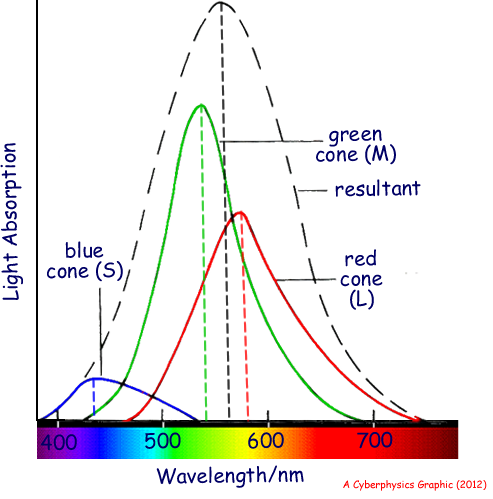Solutions: Medical Option - the EYE
Q7.
(a) Sketch the response curves for the colour cones of the eye. Label the wavelength axis with a scale appropriate for your curves.

 three overlapping colour curves labelled blue, green and red, where green is biggest and blue is smallest
three overlapping colour curves labelled blue, green and red, where green is biggest and blue is smallest 
 unit and scale on wavelength axis
unit and scale on wavelength axis 
 peaks at 430 nm (blue), 520 nm (green), 570 nm (red) (allow +/- 30 nm for each)
peaks at 430 nm (blue), 520 nm (green), 570 nm (red) (allow +/- 30 nm for each) 
 ranges 400 - 520 nm (blue), 430 - 670 nm (green), 480 - 730 nm(red) (allow +/- 30 nm for each)
ranges 400 - 520 nm (blue), 430 - 670 nm (green), 480 - 730 nm(red) (allow +/- 30 nm for each) 
(4 marks)
(b) In terms of receptors,
(i) give the condition for two different images to be resolved by the eye,
Two stimulated receptors must be separated by (at least) one unstimulated receptor for resolution. 
(ii) explain why finer detail can be seen in bright light than in dim light.
In bright light cones are activated as well as rods, whereas in dim light only rods are activated.  Cones vision is concentrated near to the fovea and separation of them is smaller than that of rods which are more prevelant at the periphery of the retina.
Cones vision is concentrated near to the fovea and separation of them is smaller than that of rods which are more prevelant at the periphery of the retina.  Angular separation is therefore smaller for colour vision than for monochrome vision.
Angular separation is therefore smaller for colour vision than for monochrome vision. 
(3 marks MAX)
(c)
(i) State what is meant by persistence of vision.
Lights flashing at more than 60 Hz appear steady
[or a moving image appears steady even though the stimulus is made up of flashing still shots as long as the flashing is at a rate of more than 60 per second] 
(ii) Give an example of a practical situation where persistence of vision is used to advantage.
When viewing animated or cine films or television the flashing images appear as smooth image transition to us. 
(2 marks)
(Total 9 marks)
Click here to see the notes on this topic.


